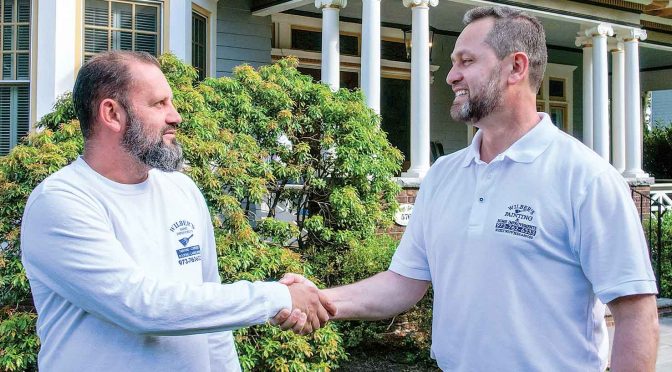In each issue of Pintor Pro magazine, senior editor Jorge Arboleda goes behind the scenes with successful painting company owners for our series, The Painting Life. This time: Wilber Vargas of Wilber’s Painting in Maplewood, New Jersey.
Beginnings
Wilber Vargas was 21 years old when he decided to leave Naranjo, Costa Rica, to come to the United States in search of opportunities. Although he was full of optimism, he probably never imagined the success that he would achieve in this country.
Founder, owner and manager of Wilber’s Painting, a firm located in Maplewood, New Jersey, Vargas employs about 250 people on a regular basis, including employees and subcontractors.
Being a town characterized by a deep-rooted colonial architecture that the city authorities try to preserve, Maplewood homes make a unique case for residential contractors like Vargas.
Pintor Pro sat down with Vargas (pictured above with field manager Christian Fernandez) with to learn more about his company.
What is the main challenge for your company?
We have many historic homes where even the colors must be approved by the city to maintain the style of Victorian homes. The most common problem is that sometimes we can’t finish a paint job because of missing carpentry work. In those colonial homes, much of the woodwork consists of duplicating the old moldings to make them look like the originals. That’s why we decided to add a carpentry repair service. That way we can move projects forward so they don’t sit idle.
How did you get into painting?
I liked painting since I lived in Costa Rica, where I painted rooms and things like that. So, when I arrived, I wanted to find work in painting and I got it; within two days of arriving in New Jersey I was already painting.
I loved this job. I sanded and painted houses, and I was happy to do it because I felt it was an easy, light labor since I was used to the hard work in the farms in Costa Rica. I was delighted. I started in 1995 so I have been doing this for 27 years. But I started like everyone else, sanding and painting.
Little by little I learned English and then I became a supervisor, estimator and salesman for a company where I worked for 12 years. Then when that company was winding down, I was ready to start my own business.
Do you only do residential painting?
Yes, 95 percent. We repair, restore, repaint. We also work on new homes, though, which are easier to paint. The older homes we paint require intensive prep work, sanding down to the wood. We duplicate moldings, restoring them as they were originally. We also replace the shingles since in many of those old houses they are warped, rotten and need to be replaced.
How many people work for the firm?
Between employees and subcontractors, we have about 250 people working, and sometimes more in the summer. For employees we have about 40 on the books, and most subcontractors work almost year-round with us, although they have their own smaller companies. You have a lot of people working for you, to what do you attribute that growth?
We’ve achieved it by being flexible with the crew. Treating the staff well and providing fair pay. And as much as possible, by being a friend.
I tell the guys to always listen to the customer and understand what they are looking for, to become their partners and treat the place where they work as if it were their own home. We are in this not just for the money but to do a good job and create a good name. You may not profit on every project, but if sometimes you didn’t get paid correctly and you’re not going to make as much as you expect, you still win by leaving a satisfied client and leaving with a good reputation. I see the company as a building where each one of us is a brick, we are all an important part of being a big company.
How has your paint supplier helped your business?
Sherwin-Williams has always been there for us and for any issues with a client. It’s one of the reasons we’ve grown like this. It’s not just a matter of giving the customer your best on the job, but giving them a good product. I’ve always been a fan of Sherwin-Williams products. To please the customer, there’s nothing better than using good products. Sherwin-Williams products are so good that I will show new customers houses that I did years ago as an example of their paint’s durability.
How would you define the moment the industry is going through?
I would say there is a scarcity of manpower. And for us, in the last year, we even lacked some painting materials, though it was solved thanks to the support of Sherwin-Williams. When there has been a shortage of material, the district manager has even gone to Texas for supplies if needed. As for labor, there are those who want to work, but have no experience or lack the desire to learn. I always want to pass on what I have learned to the guys who come to this country like I did, so that someday they can have their own businesses.
Do you have a marketing strategy?
We rely on referrals, 60 percent of our new customers come from referrals from other people. We also use Angie’s List, now called Angi. We like it because they verify that the reviews are from customers who have actually used the company’s services. We also have a website that gets a lot of hits. In addition, we use large yard signs, and all of our vans are painted with company signs.
Would you recommend painting as a career?
Of course I would. Thanks to painting I have achieved personal accomplishments that I never imagined I would have. I recommend it to anyone who wants to excel and get ahead. In my personal life, painting has led me to achievements I never imagined. It has been a great experience.
What is your advice for someone just starting out?
Be honest and look for what’s best for the client. For the guys who are working in a crew I would tell them
to be happy, because that mood rubs off on the clients. Getting started in painting is a very good thing.
Another important tip is that I recommend that you use Sherwin-Williams products, because they will help you build a good reputation, and you can be sure that the job is going to look good.
This story was published in the Summer 2022 issue of Pintor Pro magazine. ©2022 Northbrook Publishing. Story by Jorge Arboleda, Pintor Pro senior editor. Photography courtesy Wilber’s Painting. Read more stories about successful painting contractors in the Pintor Pro magazine archive.




